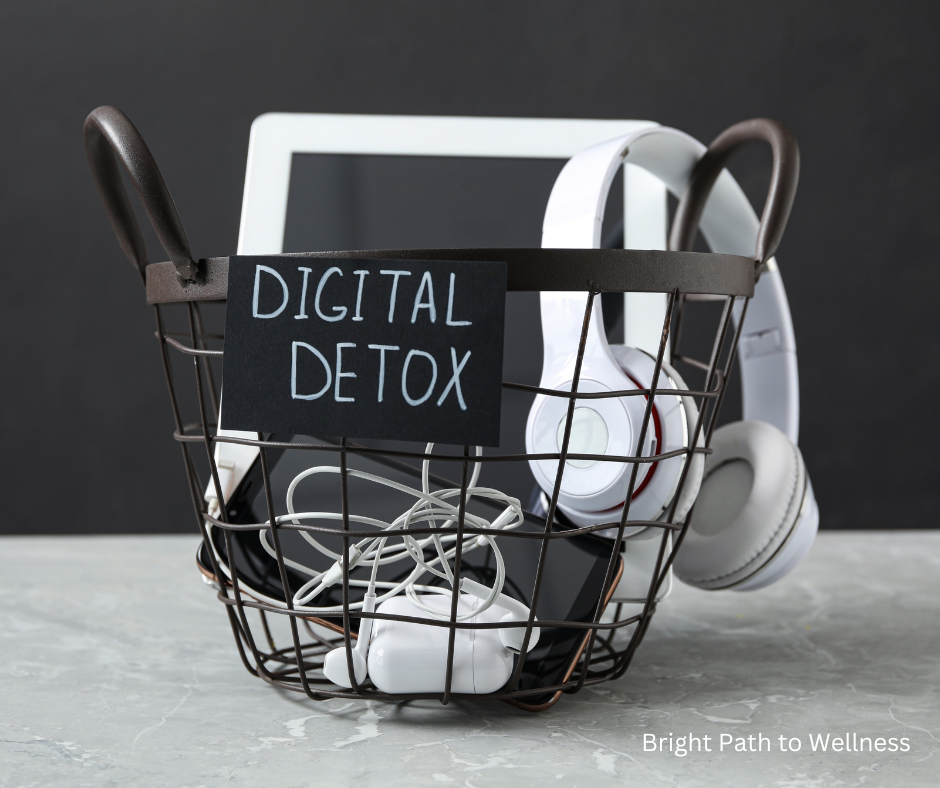Digital devices have become part of our daily routines, and we are constantly connected. While technology offers educational resources, entertainment options, and communication tools, excessive screen use correlates with negative physical and psychological health outcomes. Creating a balanced approach to technology use has become essential for family well-being.
Research1 demonstrates that extended screen engagement correlates with elevated stress markers, disrupted sleep patterns, decreased physical activity, and reduced attention spans. Implementing planned breaks from digital devices, commonly called a “digital detox”, helps families rebuild interpersonal connections, enhance mental health, and establish sustainable technology habits.
This article presents evidence-based strategies for reducing collective screen time while fostering a healthier relationship with technology.
Understanding Screen Time’s Impact on Family Health
Digital devices have transformed modern life, but excessive use carries significant consequences for development, health, and relationships. Recognizing these effects motivates meaningful change.
Physiological and Psychological Effects

- Physical Development Implications: Extended sedentary screen use replaces active play and movement, affecting children’s gross motor development, spatial awareness, and physical fitness. Research2 shows that children who exceed screen time recommendations are 30% more likely to experience weight management challenges.
- Sleep Disruption: The blue light emitted from screens suppresses melatonin production by up to 80%, interfering with circadian rhythms and reducing sleep quality. Studies3 demonstrate that evening screen exposure delays sleep onset by approximately 30 minutes and reduces REM sleep duration.
- Cognitive Load and Attention: Constant notifications and digital switching between applications create attentional fragmentation. Research4 indicates that attention spans after prolonged device use decreased by 25-30%, affecting academic performance and task completion.
- Relationship Interference: When devices command attention during family interactions, what researchers call “technoference” occurs. Studies5 show that 70% of meals in American households include device use, reducing conversation quality and emotional connection.
When families prioritize screens over direct interaction, children receive fewer opportunities for emotional regulation development and social skill acquisition, capabilities that fundamentally shape future relationship success.
Developing a Collaborative Family Approach

Effective digital management requires mutual agreement and participation. Imposed restrictions without understanding often create resistance, while collaborative planning builds commitment and motivation.
Creating a Sustainable Plan
- Inclusive Family Discussion: Begin with an age-appropriate conversation explaining the neurological and social impacts of excessive screen use. Allow each family member to express concerns, ask questions, and contribute ideas for healthier technology habits.
- Establish Measurable Objectives: Define specific, achievable goals:
- Reducing evening screen time by 1 hour initially.
- Creating two device-free meals daily.
- Implementing a one-hour buffer between screen use and bedtime.
- Designating screen-free zones in bedrooms and dining areas.
- Document Agreements: Create a family media plan outlining agreed boundaries, consequences, and exceptions. Post this document visibly as a consistent reference point.
- Progressive Implementation: Introduce changes incrementally rather than simultaneously. Before introducing additional changes, such as device-free dinners, begin with one significant modification.
- Parental Consistency: Parents who demonstrate their commitment to digital boundaries establish credibility. Research6 shows that children whose parents actively model reduced screen time are 67% more likely to adhere to similar limits.
When families collaborate on media guidelines, children develop agency in managing their technology use, a crucial skill for digital natives who will navigate increasingly complex technology environments throughout their lives.
Cultivating Engaging Alternatives to Screen Time
The most effective approach to reducing screen dependency involves replacing digital activities with equally compelling non-digital options. Creating an environment rich with alternatives prevents the common complaint: “I’m bored.”
Structured Screen-Free Activities

Movement-Based Options: Physical activity serves as a natural antidote to screen-induced sedentary behavior:
- Family bike rides or neighborhood walks after dinner.
- Weekend hiking excursions with specific destinations or goals.
- Backyard sports adapted for available space and family size.
- Dance parties with age-appropriate music selections.
Cognitive Engagement Alternatives: Activities that stimulate similar mental engagement as digital content:
- Strategic board games that grow increasingly complex with skill development.
- Puzzle stations with options ranging from 100 to 1000+ pieces.
- Educational projects extending school learning into practical applications.
- Science experiments using household materials with observable outcomes.
Creative Expression Opportunities: Activities developing self-expression and artistic skills:
- Art supplies organized in accessible stations for spontaneous creation.
- Music exploration through simple instruments and vocal experimentation.
- Storytelling activities where family members build narratives together.
- Photography projects using basic cameras to document nature or daily life.
Connection-Focused Activities: Experiences specifically designed to strengthen relationships:
- Family book clubs with age-appropriate selections and discussion questions.
- Cooking projects where each member contributes to meal preparation.
- Service activities benefiting neighbors or community organizations.
- Oral history interviews where children document family stories from older relatives.
Research7 indicates that families who maintain a “boredom toolkit” with 10-15 readily available screen-free activity options report 58% fewer requests for screen time during designated digital breaks.
Strengthening Family Bonds Through Intentional Connection
Digital devices often create what researchers call “alone together” scenarios, with family members physically present but psychologically absent due to screen engagement. Prioritizing authentic connections counteracts this phenomenon.
Strategic Connection Opportunities
Protected Mealtime Interactions: Designate meals as device-free zones focusing on conversation:
- Implement conversation starters for younger children.
- Practice active listening techniques as a family skill.
- Create rotating responsibility for mealtime discussion topics.
- Establish consistent mealtime rituals that create predictability and security.
Designated Technology-Free Periods: Schedule specific blocks completely free from screens:
- Daily: One-hour connection periods during typical high-energy times.
- Weekly: Extended afternoon or evening unplugged experiences.
- Monthly: Full-day adventures without digital interference.
- Annually: Vacation experiences with minimal technology access.
Physical Connection Practices: Counteract the physicality of screen interactions:
- Regular family walks with conversation prompts.
- Physical games appropriate for various ages and abilities.
- Comfortable reading spaces accommodating multiple family members.
- Outdoor exploration emphasizing sensory experiences unavailable digitally.
Ritual Development: Create family traditions that don’t involve screens:
- Sunday game tournaments with rotating game selection.
- Friday evening recipe experimentation.
- Seasonal outdoor adventures tied to environmental changes.
- Holiday traditions emphasizing presence over presents.
Studies8 demonstrate that families implementing just four screen-free hours weekly report 40% higher relationship satisfaction scores and significantly improved communication quality between parents and children.
Maintaining Digital Balance Long-Term
Initial enthusiasm for digital reduction often diminishes without systems supporting ongoing practice. Creating sustainable habits requires consistent reinforcement and adaptation.
Sustainable Implementation Strategies
Regular Assessment Process: Schedule periodic family meetings to evaluate progress:
- What is working well in our current approach?
- Which boundaries create unnecessary friction?
- How have relationships and activities improved?
- What adjustments would better serve our family goals?
Progress Documentation: Track improvements in non-digital areas:
- Sleep quality improvements.
- Academic focus enhancement.
- Mood regulation development.
- Social skills advancement.
- Physical activity increases.
Gradual Boundary Evolution: Adjust limits as digital maturity develops:
- Age-appropriate progression of responsibility.
- Earned independence through demonstrated judgment.
- Conversation-based problem-solving when challenges arise.
- Collaborative development of new guidelines as children mature.
Technology Integration Education: Teach critical evaluation of digital tools:
- Distinguishing between consumption and creation.
- Evaluating apps and platforms for actual value.
- Understanding attention manipulation techniques.
- Developing personal criteria for technology adoption.
Balance Rather Than Elimination
Reducing family screen time centers on creating balance rather than demonizing technology. The goal is not eliminating digital tools but ensuring they enhance rather than diminish family well-being.
By understanding screen time impacts, creating collaborative plans, cultivating compelling alternatives, strengthening genuine connections, and maintaining consistent practices, families develop healthier relationships with both technology and each other.
Consider beginning with a one-week family experiment, reducing screen time by 25% and replacing it with alternative activities, to experience firsthand the benefits of digital balance.
If you found this article helpful, share it with someone who might need it. Do you have any experience to add? Drop them in the comments. I would love to hear from you!
About the Author
Carla Picolli is a psychologist, sleep expert, author, and mental health advocate. With over two decades of experience in mental health and wellness, Carla helps individuals build sustainable habits for a healthier, happier life.
References
- https://pmc.ncbi.nlm.nih.gov/articles/PMC9638701/
- https://pubmed.ncbi.nlm.nih.gov/30606703/
- https://journals.physiology.org/doi/full/10.1152/japplphysiol.00165.2011
- https://www.pnas.org/doi/10.1073/pnas.0903620106
- https://pubmed.ncbi.nlm.nih.gov/28493400/
- https://www.sciencedirect.com/science/article/abs/pii/S0193397314001439
- https://www.pewresearch.org/internet/2018/07/03/stories-from-experts-about-the-impact-of-digital-life/
- https://journals.sagepub.com/doi/full/10.1177/0265407518769387


Very salient points! Technology is awesome and very useful. It’s also all too easy to go down rabbit-holes and spend too much time in front of a screen. Being in my 60s, the solutions to the “screen time” problem remind me of my childhood in the 1970s. We need find some quality “analog” time in our daily lives! We’ll get a lot more done in our digital worlds with less screen time when we strike balance!
Thank you for sharing this!
Thank you for sharing your perspective, Oren! I love your reflection on the 1970s and the value of “analog” time. So much of what we consider “screen-free” today was just daily life back then! My childhood was also very free, running and playing in the street with other children, without electronics, and I am (and was) very happy.
I really enjoyed the article, particularly the implementation strategies. I have seen the resistance that can come from attempting to implement such digital reduction. Lets not leave out eh audio interference we get in relationships from digital podcasts or music. One of my peeves is earbuds. Some of my family members get upset when trying to speak with them while plugged in. I like the substitution concept replacing the screen time. Great article!
I’m glad you enjoyed the article, Jay! Thanks for your time and comment!
This is a very good instructive article for limiting digital interference in family relationships. I particularly like the implementation with substitutions for screen time. The article didn’t mention anything about digital interference through audio, such as use of earbuds etc.. This is a real thing in my family. Love the instructional within the article.
Thank you for your words, Jay! You bring up a great point about digital interference through audio, like earbuds, which can be just as disruptive as screens. It’s something many families experience, yet it’s often overlooked! A great strategy is to set “tech-free listening zones” during key moments, like meals or family activities, to encourage more presence and interaction.
Carla, this is such an insightful and well-researched article! The emphasis on a balanced approach rather than total elimination of digital devices is refreshing and practical for modern families. I particularly appreciate the focus on structured, engaging alternatives to screen time—offering concrete, realistic activities that encourage movement, creativity, and connection. The section on “technoference” really stood out, highlighting how even seemingly small digital distractions can disrupt meaningful interactions. The statistics and research citations add credibility, making a strong case for intentional screen-time management. Also, the idea of a family media plan is brilliant—it fosters accountability and ensures consistency. The “boredom toolkit” suggestion is another gem, helping families proactively handle screen-free moments. Implementing just a few of these strategies could make a significant difference in family well-being. Thank you for sharing these practical solutions! Looking forward to more of your insights on fostering a healthier digital balance.
I’m really glad that you enjoyed the article, Andre! A balanced approach and small changes can create a healthier, more connected family dynamic. Have a great day!